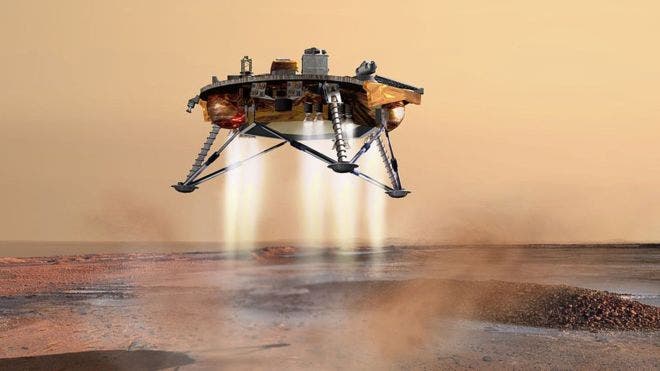
Artist impresion of the InSight probe gently touching down on Mars with its descent engines fired on. Credit: NASA.
NASA just landed the InSight probe on Mars after traveling more than 300 million miles through space for 205 days. InSight slowed down from a staggering 12,300 mph to 5 mph in under 6 minutes, piercing through the thin Martian atmosphere while it deployed its parachute and descent engines.
📸 Wish you were here! @NASAInSight sent home its first photo after #MarsLanding:
InSight’s view is a flat, smooth expanse called Elysium Planitia, but its workspace is below the surface, where it will study Mars’ deep interior. pic.twitter.com/3EU70jXQJw
— NASA (@NASA) November 26, 2018
NASA engineers held their breath witnessing the delicate transition from soaring through the Martian atmosphere at breakneck speed to gently touching down on the surface of the Red Planet. Among NASA scientists, this is known as “the seven minutes of terror” — because the landing is completely out of their direct control, and it takes about seven minutes, of course.
Our @NASAInSight spacecraft stuck the #MarsLanding!
Its new home is Elysium Planitia, a still, flat region where it’s set to study seismic waves and heat deep below the surface of the Red Planet for a planned two-year mission. Learn more: https://t.co/fIPATUugFo pic.twitter.com/j0hXTjhV6I
— NASA (@NASA) November 26, 2018
The one-of-a-kind Mars explorer landed on a region called Elysium Planitia, a flat landscape where it will study the slight rumbles and tremors produced as the planet wobbles. Just like ‘earthquakes’, these are ‘marsquakes’ — and whatever waves the lander’s instruments will pick up might help scientists gain unprecedented insights about Mars’ interior, from its crust to its very core. This is the first mission to Mars dedicated to studying the planet’s interior.
Like earthquakes, marsquakes are vibrations of the ground. However, while an earthquake is produced by the movement of tectonic plates, scientists believe that marsquakes occur when the planet cools and contracts, causing the crust to ruck up slightly. Scientists believe that all planetary bodies experience quakes, ranging from those that vibrate fast to those that rumble low. In the 1970s, NASA’s Viking lander tried to measure quakes on Mars but its instruments weren’t sensitive enough. However, during the Apollo missions, seismometers measured thousands of tiny quakes on the moon.
InSight will also help scientist come to a better understanding of how the solar system formed and evolved. Both Mars and Earth are rocky planets that had lots of water on their surface during their rich history. However, the two planets look very differently today — Earth is wet and teeming with life while Mars is barren and dead.
So now that InSight safely landed on Mars, what’s next? Right now, NASA engineers are busy deploying the probe’s array of solar panels so it can start generating energy as soon as possible. Over the next couple of days, NASA will perform checkouts to ensure that everything is in tip-top shape, then it will deploy the scientific instruments. It’s the first time that NASA will use a robotic arm to deploy instruments on the surface of Mars, among them the precious seismometer and a heat flow probe. Immediately, NASA will start recording data about temperature, wind, and other atmospheric parameters but it will take at least three months before there will be any seismic data. That’s because NASA wants to make sure that the instruments are properly set up and calibrated. Expect interesting new science about Mars via Insight beginning with March 2019.









